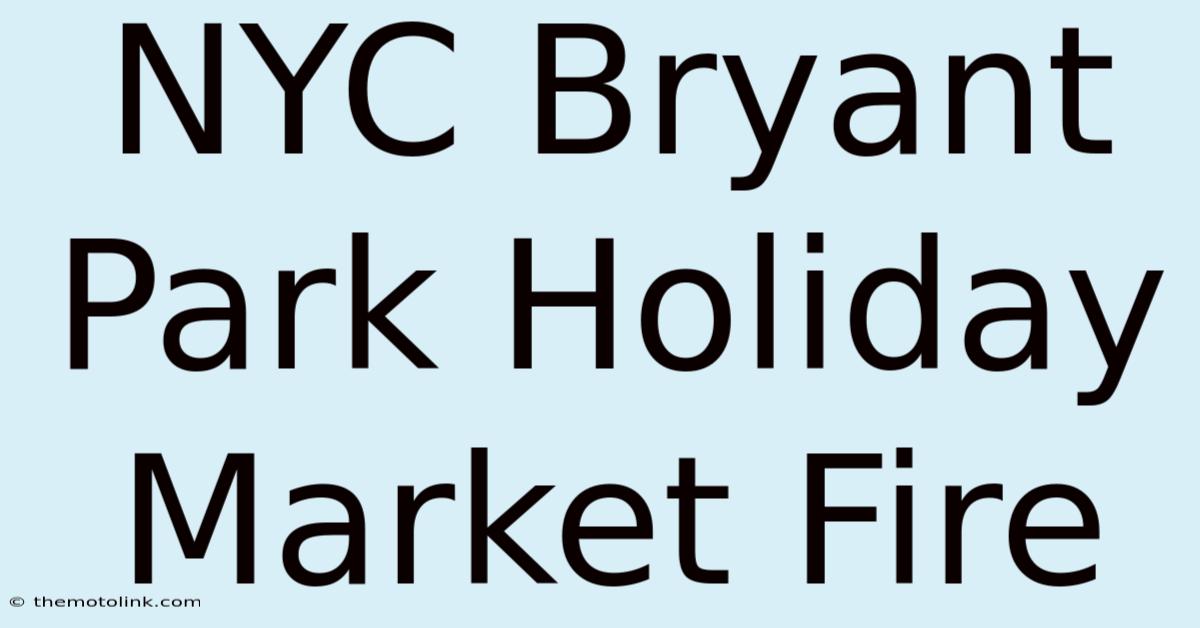NYC Bryant Park Holiday Market Fire

Discover more detailed and exciting information on our website. Click the link below to start your adventure: Visit Best Website nimila.me. Don't miss out!
Table of Contents
NYC Bryant Park Holiday Market Fire: A Close Call and Lessons Learned
A recent, thankfully minor, fire at the iconic Bryant Park Winter Village Holiday Market served as a stark reminder of the importance of fire safety, especially in densely populated areas during the holiday season. The incident, while quickly contained, sparked concerns about preparedness and the potential for larger-scale disasters in similar settings. This article will delve into the details of the event, examine its causes and consequences, and explore crucial lessons learned for future holiday market safety.
The Incident: A Quick-Moving Blaze
On [Insert Date of Fire Here], a fire broke out at the Bryant Park Winter Village Holiday Market. Initial reports suggested the blaze originated near [Insert Location of Fire Origin, e.g., a food stall, vendor booth]. The fire quickly spread due to [Insert Contributing Factors, e.g., dry materials, proximity of vendors], prompting immediate evacuation of the market and a swift response from the New York City Fire Department (FDNY). Luckily, the fire was contained relatively quickly, minimizing property damage and preventing injuries. However, the incident forced the temporary closure of a section of the market, disrupting holiday shopping and causing significant inconvenience for vendors and visitors.
Causes and Contributing Factors: A Detailed Examination
While a full investigation is still underway, preliminary reports suggest that [Insert Confirmed or Likely Cause of Fire, e.g., faulty electrical wiring, unattended cooking equipment] played a significant role in the fire's ignition. [Insert Details about Contributing Factors, e.g., The high volume of foot traffic and the close proximity of wooden structures and flammable materials may have contributed to the rapid spread of the flames]. This highlights the critical need for rigorous fire safety inspections and adherence to strict regulations within temporary market structures. The fire underscores the importance of proactive measures to mitigate risks associated with overcrowding and the use of potentially hazardous equipment.
Safety Protocols and Response: Lessons Learned and Improvements
The FDNY's rapid response was crucial in preventing a more serious incident. Their efficient evacuation procedures and quick containment of the fire minimized damage and prevented injuries. However, the event necessitates a review of existing safety protocols. Key takeaways include:
- Enhanced Fire Suppression Systems: Consideration should be given to installing more robust fire suppression systems in high-traffic areas within the market.
- Improved Fire Alarm Systems: Ensuring the market has a reliable and easily accessible fire alarm system is paramount.
- Regular Inspections: More frequent and thorough fire safety inspections should be mandated for all vendors and structures within the market.
- Vendor Training: Comprehensive fire safety training should be provided to all vendors, emphasizing safe handling of equipment and emergency procedures.
- Emergency Evacuation Plans: Clearly marked evacuation routes and regular practice drills should be implemented to ensure efficient and safe evacuation in emergencies.
Future Implications: Strengthening Holiday Market Safety
The Bryant Park incident serves as a crucial reminder of the importance of fire safety in temporary structures, especially during peak seasons like the holidays. This event will likely prompt a city-wide reassessment of safety regulations for similar events. Future holiday markets may see:
- Stricter Permitting Processes: More rigorous inspections and stricter adherence to fire safety codes are anticipated.
- Increased Security Personnel: A greater presence of security personnel trained in fire safety procedures might be implemented.
- Improved Communication Systems: Enhancements in communication systems to ensure rapid and effective dissemination of information during emergencies.
Moving Forward: A Call for Collaboration and Vigilance
The Bryant Park Holiday Market fire, while a setback, should not overshadow the joy and tradition associated with the holiday season. However, it highlights the need for continuous improvement in fire safety measures. Collaboration between city officials, market organizers, and vendors is essential to ensure the safety and security of all participants and visitors to future events. What are your thoughts on improving holiday market safety? Share your insights below!
FAQs (with Schema Markup suggestions)
- Q: Was anyone injured in the Bryant Park Holiday Market fire? A: No injuries were reported. (Schema:
{"@type": "FAQPage", "mainEntity": [{"@type": "Question", "name": "Was anyone injured in the Bryant Park Holiday Market fire?", "acceptedAnswer": {"@type": "Answer", "text": "No injuries were reported."}}]}) - Q: What caused the fire at the Bryant Park Holiday Market? A: The exact cause is still under investigation, but [Insert Preliminary Findings]. (
{"@type": "FAQPage", "mainEntity": [{"@type": "Question", "name": "What caused the fire at the Bryant Park Holiday Market?", "acceptedAnswer": {"@type": "Answer", "text": "The exact cause is still under investigation, but [Insert Preliminary Findings]."}}]})
(Suggested Images/Videos):
- Image of the Bryant Park Holiday Market (pre-fire) - Alt text: "Bryant Park Holiday Market before fire incident"
- Image of the fire response (if available) - Alt text: "FDNY responding to Bryant Park Holiday Market fire"
- Infographic summarizing key safety improvements - Alt text: "Infographic: Key safety improvements for holiday markets"
(Internal Links): [Link to an article about NYC fire safety regulations], [Link to an article about holiday safety tips], [Link to an article about winter event safety].
(External Links): [Link to FDNY website], [Link to a relevant news article about the fire].

Thank you for visiting our website wich cover about NYC Bryant Park Holiday Market Fire. We hope the information provided has been useful to you. Feel free to contact us if you have any questions or need further assistance. See you next time and dont miss to bookmark.
Featured Posts
-
Mega Millions Lottery Winning Numbers
Dec 28, 2024
-
Olivia Hussey Romeo Juliet Star Dies
Dec 28, 2024
-
Greg Gumbel Passes Away At 78
Dec 28, 2024
-
2024 Holiday Bowl Syracuse Vs Washington State Odds
Dec 28, 2024
-
Torres Tigers Agree 15 Million
Dec 28, 2024
